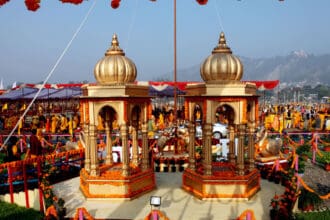Gagan Mahal, a prominent monument in Bijapur, is a majestic building that stands as a testament to the architectural and cultural excellence of the Adil Shahi dynasty. Built in the 16th century, Gagan Mahal served as the royal palace and the administrative center of the Bijapur Sultanate. In this article, we’ll explore the fascinating history and architectural features of Gagan Mahal, along with the cultural significance of this historical marvel.
History of Gagan Mahal
Gagan Mahal was built by Ali Adil Shah I, the fifth Sultan of the Adil Shahi dynasty, in the early 17th century. It was originally constructed as the royal palace and was later converted into the administrative center of the Bijapur Sultanate. The palace was named “Gagan Mahal” or “Sky Palace” due to its location on a raised platform that provided a panoramic view of the surrounding area.
During the reign of Muhammad Adil Shah, the third Sultan of the Adil Shahi dynasty, Gagan Mahal underwent extensive renovations, including the addition of a new facade and a Durbar Hall, where the Sultan held court.
After the decline of the Adil Shahi dynasty, Gagan Mahal fell into disrepair and was used as a granary by the British colonial administration. It was only in the mid-20th century that the Archaeological Survey of India took over the maintenance of the palace and restored it to its former glory.
Architecture of Gagan Mahal
Gagan Mahal is an impressive example of the Deccan style of architecture that was prevalent during the Adil Shahi dynasty. The palace is built on a raised platform and has a rectangular plan. It has three stories, with the ground floor being used for administrative purposes and the upper floors for residential purposes.
Exterior
The exterior of Gagan Mahal is characterized by its towering arches and intricately carved stone facades. The palace has two main entrances, one on the east and one on the west, with a large open courtyard in between. The courtyard is surrounded by arched arcades and has a large water tank in the center.
Interior
The interior of Gagan Mahal is equally impressive, with ornate columns, vaulted ceilings, and elaborate carvings. The Durbar Hall, located on the first floor, is the most impressive room in the palace. It has a high ceiling and is adorned with intricate stucco work and paintings.
Cultural Significance of Gagan Mahal
Gagan Mahal is not only a significant historical monument but also a cultural landmark of Bijapur. The palace played an important role in the social and cultural life of the Adil Shahi dynasty, with the Sultan holding court in the Durbar Hall and hosting cultural events in the courtyard.
Today, Gagan Mahal continues to be a popular tourist attraction and a source of pride for the people of Bijapur. It is a testament to the rich cultural heritage of the region and serves as a reminder of the grandeur and sophistication of the Adil Shahi dynasty.
How to Reach Gagan Mahal
Gagan Mahal is located in the heart of Bijapur and is easily accessible by road. The nearest airport is in Belgaum, which is about 205 km away, while the nearest railway station is in Bijapur itself. From the station, visitors can hire a taxi or take a local bus to reach Gagan Mahal.
Best Time to Visit Gagan Mahal
The best time to visit Gagan Mahal is during the winter months, between October and February, when the weather is pleasant and the skies are clear. The summer months, between March and May, can be very hot and humid, while the monsoon season, between June and September, can bring heavy rainfall and make sightseeing difficult.
Nearby Tourist Attractions
Bijapur is home to many other historical monuments and tourist attractions, including the Ibrahim Rouza, Gol Gumbaz, and the Jumma Masjid. Visitors can also explore the local bazaars and markets, which offer a glimpse into the vibrant culture and traditions of the region.
Interesting Facts about Gagan Mahal
- Gagan Mahal was once one of the largest and most opulent palaces in South India.
- The palace was designed to be a replica of the Gol Gumbaz, the iconic mausoleum of Muhammad Adil Shah.
- The Durbar Hall of Gagan Mahal was used to host cultural events, including music and dance performances.
- The palace has a secret passage that leads to the nearby Jami Masjid.
- Gagan Mahal was used as a granary by the British colonial administration before it was restored by the Archaeological Survey of India.
Conclusion
Gagan Mahal is a magnificent monument that stands as a symbol of the rich cultural heritage of Bijapur. Its impressive architecture and fascinating history make it a must-visit destination for anyone interested in the history and culture of South India. Whether you’re a history buff or a casual tourist, a visit to Gagan Mahal is an experience you won’t soon forget.
FAQs about Gagan Mahal
1. What is the entry fee for Gagan Mahal?
The entry fee for Gagan Mahal is INR 10 for Indian nationals and INR 100 for foreign nationals.
2. What are the timings of Gagan Mahal?
Gagan Mahal is open to visitors from 10:00 am to 5:00 pm every day.
3. Is photography allowed inside Gagan Mahal?
Yes, photography is allowed inside Gagan Mahal, but visitors are not allowed to use flash or tripods.
4. What is the best time to visit Gagan Mahal?
The best time to visit Gagan Mahal is during the winter months, between October and February, when the weather is pleasant and the skies are clear.
5. What are the nearby restaurants to Gagan Mahal?
There are several restaurants and eateries located near Gagan Mahal, serving a variety of local and regional cuisines.







